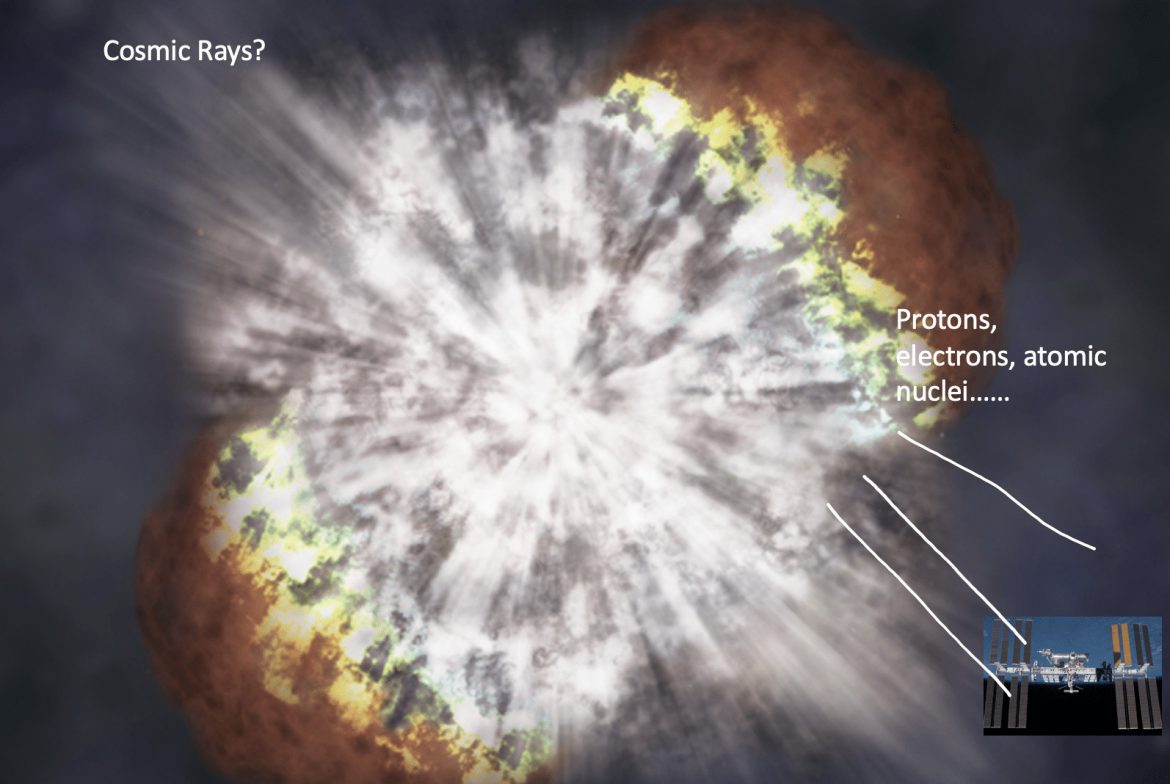Cosmic rays aren’t just massless radiation like Light, but are “direct samples of matter from outside the Solar System” — (NASA, 2017). So, here’s the introduction to cosmic rays.
What Are The Particles of Cosmic Rays?
Well, cosmic rays have electrical charges, like protons and electrons. In fact, about 90% of cosmic rays are protons. Thus, magnetic fields can deflect them. That’s also why looking for their sources is burdensome. We need to accurately predict the interstellar magnetic fields’ location and the particles’ paths to find out where they come from2.
Some of the other 10% are neutrinos, particles as small as electrons but are chargeless. Furthermore, they rarely interact with other particles that they usually pass through even the most sensitive detectors on Earth like a passer-by, without being detected.
To further know about its composition, we need to measure the number of protons and neutrons in a nucleus. This action can help us know more about what particles are more abundant in the Universe, especially the particles’ source.
So, where do they originate?
In 2013, scientists found one source of cosmic rays, and is on in a Space article in 2013. When a star explodes in a Supernova, the magnetic fields trap the photons and put them in a speedy shock wave, nearly the speed of light. This phenomenon is the Fermi acceleration.
Why was the source mysterious for so long? That’s because scientists initially thought they are gamma-rays, so detecting the source wasn’t that difficult. However, further experiments said that they are charged particles instead of light1. Interestingly enough, the origins of cosmic rays have been a mystery for 100 years before the major discovery.
Threats of Space Radiation
Any kinds of radiation, including cosmic rays, are harmful when the levels exceed the limit. They can increase the chances of cancer and nervous system diseases, to protect the astronauts who are at risk effectively.
Wait, how can astronauts be at risk if we don’t have the concern? It turns out that we are sheltered by Earth’s magnetic field that deflects many charged particles out of its way. Even though some can enter the bubble of protection, our atmosphere and radiation belts can still prison them, making them unable to get to the ground and creating beautiful auroras simultaneously.
After all, we need some materials that absorb individual protons and nuclei better in space so that the probe can protect the people inside and cause them fewer problems.
The Oh-My-God Particle
So, do you want to hear about extreme cosmic rays? We’re sure you are! So, let’s introduce the Oh-My-God particle, first discovered in 1991. These peculiar photons run at about 99.99999999999999999999951%4 the speed of light. Yes, we weren’t kidding since it was literally that fast and furious, and it contains more energy than the most powerful from the LHC (Large Hadron Collider). Considering how light the photon is, it is like an athlete decently throwing a baseball, only smaller than an atomic nucleus. Due to time dilation, it can reach Proxima Centauri in 0.43 milliseconds, on the proton’s perspective!
In addition, remember the principle that any things that have mass can’t reach the speed of light (c). Also, the energy needed to achieve faster speeds exponentiates when the velocity is near c. So, just think about how amazing that is. Did you exclaim, “OMG!” after reading the number with many “9”s? Let us know in the comments.
Information Credit: (Space, 2018)4
So, here’s the introduction to cosmic rays, where they come from, and how they can be really deranged. I hope you can learn more about this topic in the references below (1, 2, 3 and 4).
References and Credits
- David J. Eicher, (2019, July 1). Where Do Cosmic Rays Come From? – Astronomy Magazine. Retrieved November 20, 2020, from https://astronomy.com/magazine/greatest-mysteries/2019/07/21-where-do-cosmic-rays-come-from
- (2017, July). Cosmic Rays – Introduction – Imagine the Universe! – NASA. Retrieved November 20, 2020, from https://imagine.gsfc.nasa.gov/science/toolbox/cosmic_rays1.html
- Charles Q. Choi, (2013, February 14). Mystery Solved! Cosmic Rays Born in Star Explosions | Space. Retrieved November 20, 2020, from https://www.space.com/19786-cosmic-rays-origins-star-explosion.html
- Paul Sutter, (2018, August 13). High-Energy Whodunit: The Origins of the ‘OMG Particle’ | Space. Retrieved November 20, 2020, from https://www.space.com/41458-omg-particle-cosmic-ray-mystery.html
- (n.d.). International Space Station | NASA. Retrieved November 20, 2020, from https://www.nasa.gov/mission_pages/station/main/index.html
- (n.d.). What Is a Supernova? | NASA Space Place – NASA Science for Kids. Retrieved November 20, 2020, from https://spaceplace.nasa.gov/supernova/en/

